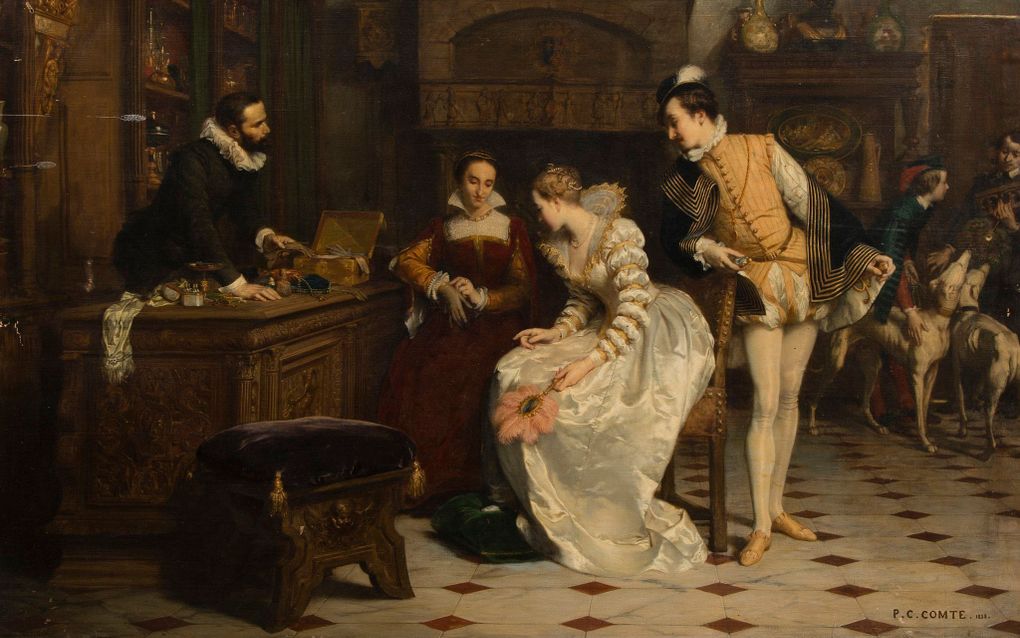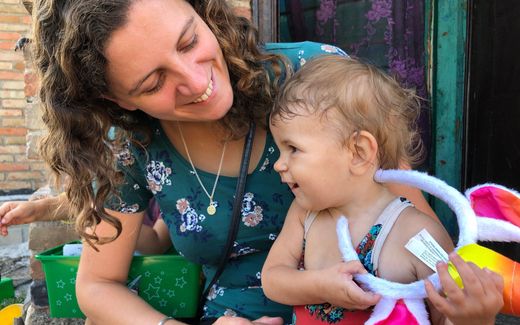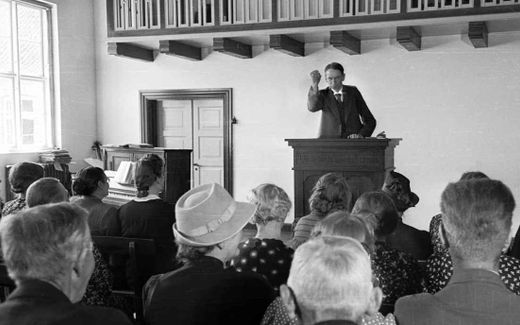Jeanne d’Albret, a Calvinistic Deborah
19-07-2022
Western Europe
Esther Karels-Boonzaaijer, RD

Jeanne d'Albret, accompanied by her son Henri de Navarre and Marguerite de Valois, comes to buy from René, perfumer of Catherine de Médicis, the gloves that poisoned her. A painting from Pierre Charles Comte. Photo Wikimedia Commons
Western Europe
King Francis I attends the marriage ceremony of his niece Joan of Albret in person. He pushed the marriage through. Brave and stubborn as she is, twelve-year-old Jeanne defies her powerful uncle: halfway down the aisle, she refuses to continue her way to the altar. This year marks the 450th anniversary of the death of the "queen of the Huguenots."
June 1541. The town of Châtellerault, located in central France, is getting ready for a big wedding party. The bride is none other than the only daughter of Margaret of Valois, sister of the French king, and Henry II, king of Navarre. The young bride wears a gold dress studded with precious stones and a red cloak trimmed with precious ermine fur, a symbol of royal dignity.
Then there is the dramatic moment in the cathedral: the bride stubbornly refuses to walk to the altar. She does not want to marry the Duke of Cleves. There is commotion, and horrified whispers fill the cathedral. The king cannot let this happen. He orders General Montmorency to force the bride to walk on. The general grabs Jeanne firmly and forces her to kneel before the altar.
The incident makes it clear that even at a young age, Jeanne is not one to be trifled with and that she has a strong will. It will serve her well when she later sides with the persecuted Huguenots and, like a "Calvinist Deborah," defends the interests of this small flock.
Chess piece
On November 16, 1528, the princess is born in the palace of Saint-Germain-en Laye near Paris. Her father is the king of Navarre and Béarn, two independent principalities located north of the Pyrenees. His territory is small but prosperous and of great strategic importance, located on the border between France and Spain. Her mother is the brilliant Margaret of Valois. Someone who is sympathetic towards the new evangelical ideas. She has contacts with various preachers and reformers, including John Calvin.

During the first years of her life, Jeanne grows up in relative peace. She receives a thorough education, for as the king's niece, she will soon have to enter the European theater.
Already around her 10th birthday, people are busy finding a suitable marriage partner for her. Like most princesses of that time, she functions as a pawn on the chessboard of all kinds of diplomatic interests. Her father's interest is to regain the Spanish part of his kingdom of Navarre. Philip II, son of Charles V, seems to him a suitable candidate for marriage. Mother Margaret, who has Calvinist sympathies, is unhappy about this. Her brother Francis I is even less pleased because Charles V is his sworn enemy.
The king's choice falls on the German Duke William of Cleves, and that choice prevails, very much against Jeanne's wishes. After the marriage, William of Cleves returns to the Rhineland. When William gives up his alliance with France, Francis I is so angry that he agrees to dissolve the marriage, which has not yet been consummated.
Charming prince
The question of finding a suitable suitor is delicate; it is only after the death of Francis I that things begin to move again. Antoine de Bourbon, a descendant of the royal house of Bourbon, is put forward. This candidate with a Protestant profile meets with Jeanne's mother's approval. And especially of Jeanne, who falls deeply in love with the charming prince. They marry in 1548. Jeanne usually stays at the castle in Pau, the capital of Béarn-Navarra, while her husband is generally on a military mission. The two write each other letters. He often signs with "your good and faithful husband."

Unfortunately, the latter is not true because, after a few happy years of marriage, it turns out that Antoine is not so strict about marital fidelity. In 1554, he even conceives a bastard. Another stain on their marriage is that Antoine increasingly sides with the Roman Catholics and Jeanne with the Huguenots.
Anchor in heaven
When Jeanne's father passes away, she and Antoine are crowned king and queen of Navarre in a Catholic ceremony. After that, Jeanne emphatically takes the helm. She allows Reformed worship services and ministers in her territories. Following in her mother's footsteps, she openly sympathises with the Huguenots. Still, it has not yet come to a break with the Roman Catholic Church. Especially a deeply embedded loyalty to the king makes it incredibly difficult to take that step.
In August 1560, John Calvin's friend Theodore Beza visits and exhorts Antoine and Jeanne to choose the right cause. Antoine retreats, but for Jeanne, it is the exhortation she needs. On Christmas Day of that year, she partakes of the Lord's Supper, making a personal profession of faith. Pressure is applied from various quarters to recant her faith, but that path is closed. The reformer John Calvin encourages her in a letter, "Do not grow weary of standing firm, for you have God for your support (...). Though the whole world falters, we shall surely arrive in the good harbour if our anchor is fixed in heaven."
Jeanne's husband dies on the battlefield two years later. After that, she becomes even more active in spreading and advocating the Reformed doctrine. She initiates translations into the national languages of Calvin's Catechism, Marot's psalm book, and the New Testament. There will even be a Protestant academy in Orthez. Meanwhile, she maintains correspondence with Protestant leaders such as Gaspard de Coligny and Queen Elizabeth I of England.
Selling jewellery
In 1568, the third religious war between Protestants and Catholics breaks out. The situation becomes too dangerous for Jeanne, and she flees with her son Henry (later King Henry IV) and daughter to the protestant city of La Rochelle. There she takes on all kinds of administrative tasks, inspects the Protestant armies with De Coligny, sells her jewels and uses the money to finance the war effort. During this time, she rightfully acquires the name of "Calvinist Deborah". Of necessity, she negotiates peace with Catherine de' Medici, who calls her "the most shameless woman in the world." A peace agreement is signed. It grants the Huguenots more freedom than ever before.
It must be a prelude to the next step: the marriage between Jeanne's son and Catharine's daughter, an alliance between the Bourbons and the Valois, between Roman Catholic and Protestant.
Jeanne goes to Paris to make preparations. However, she soon falls seriously ill. It is tuberculosis, and a few days later, she dies, on June 9, 1572, at the age of 43. She is taken away "before doom", before the terrible "Blood Wedding," on August 23 of that year.
Jeanne d’Albret as a poet
Contemporaries described Margaret, mother of Jeanne of Albret, as having "the body of a woman, the heart of a man and the head of an angel." The erudite woman left an extensive body of work. She favoured the Reformation and gave shelter to persecuted Protestants.
Jeanne would follow in her mother's footsteps and even go further because she broke with the Roman Catholic Church in 1560. Like her mother, she loved writing and poetry and did so not without merit. Once when she was visiting Henri Estienne's print shop, the latter asked her to write an "impromptu," a short, improvised poem with a meaningful thought. Jeanne complied with the request and wrote the following poem (freely translated):
"Special craft, let now and henceforth, To the children of my posterity, understand, That I have followed in the footsteps of the God-fearing, That they may stand in the same way."
Contemporary events
1527 – birth of Philip II, oldest son of Charles V
1536 – publication of the first edition of Calvin's Institution
1566 – wave of iconoclasm in the Netherlands
1572 – St. Bartholomew's Day massacre, the massacre of the Huguenots
1583 – William of Orange marries Louise de Coligny. Her father, Gaspard, was killed in the St. Bartholomew's Day massacre
1598 – Edict of Nantes, signed by Henry IV; it granted the Protestants freedom of religion
Poisoned or not?
To quell rumours that Jeanne had died a non-natural death, an autopsy was performed on her body. It revealed that she had died of lung disease. Nevertheless, stories subsequently circulated that she had been poisoned. The Protestant historian Agrippa d'Aubigné (1552-1630) suggested that Catherine de' Medici had commissioned her Italian perfumer to poison gloves, which she then gave as a gift to Joan of Albret. The famous writer Alexandre Dumas adopted this story in his novel "Queen Margot." Afterwards, it has also been written down or suggested as accurate by other historians. However, historical research has shown that poisoning is not only an unlikely scenario but also that there is no evidence for it.
This article was translated by CNE.news and previously published in Dutch daily Reformatorisch Dagblad on May 19th, 2022.
Related Articles






